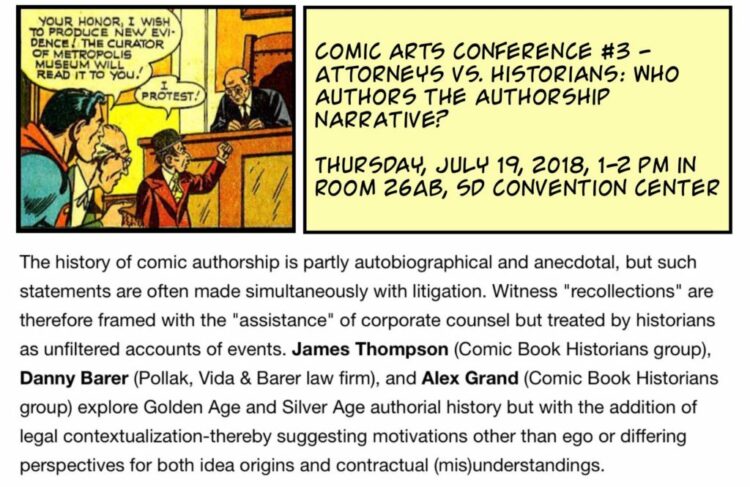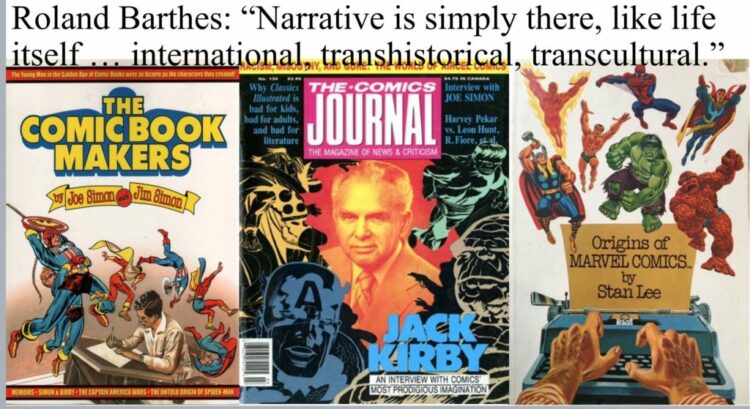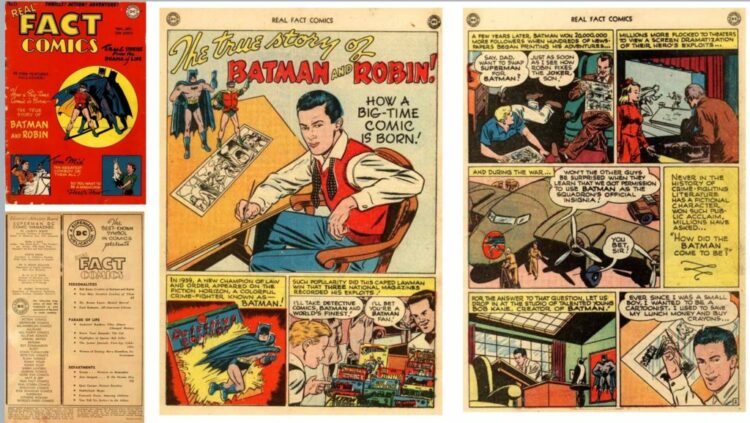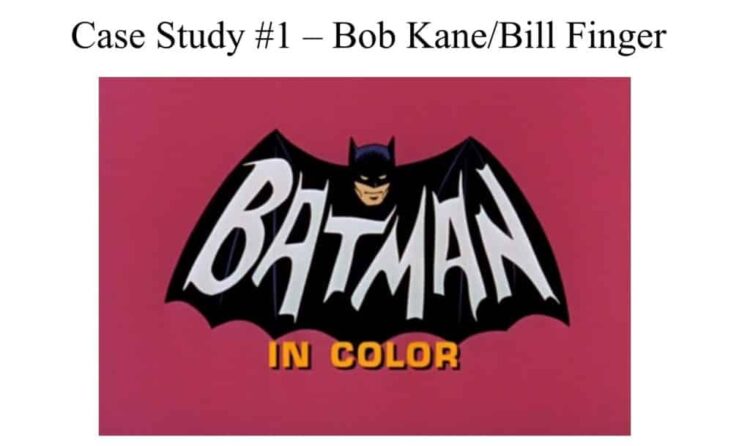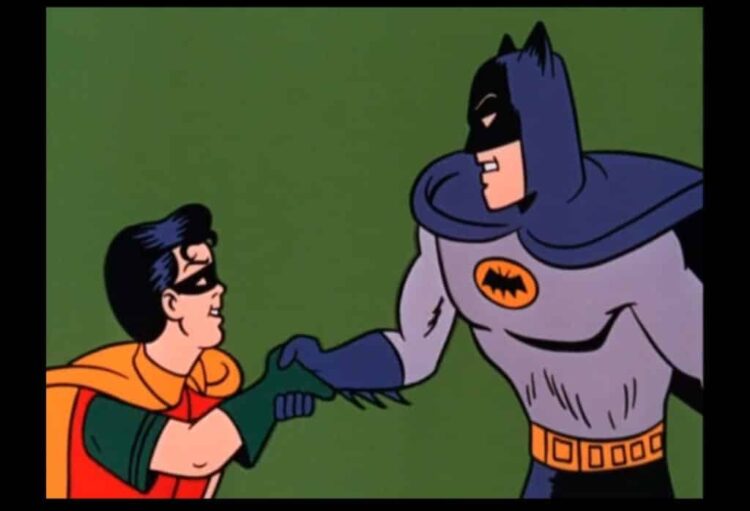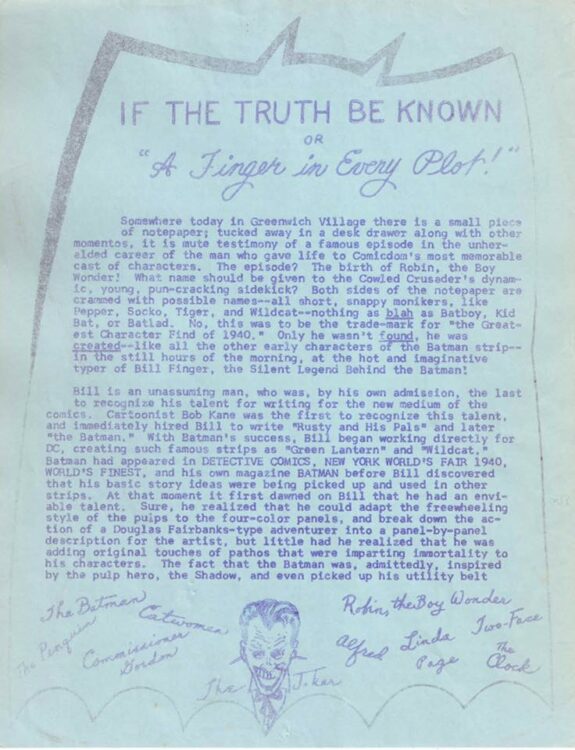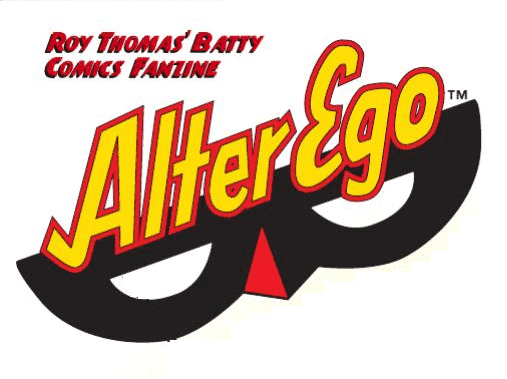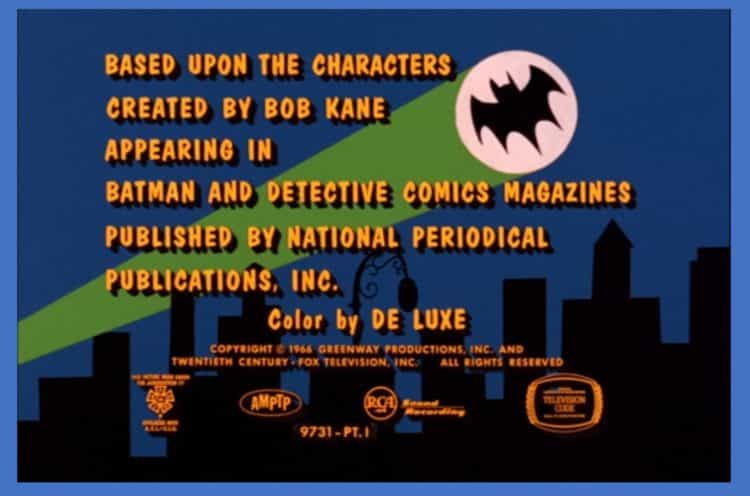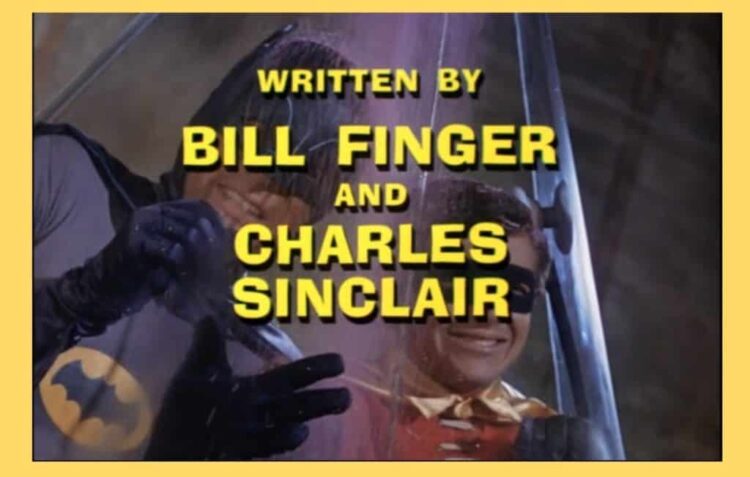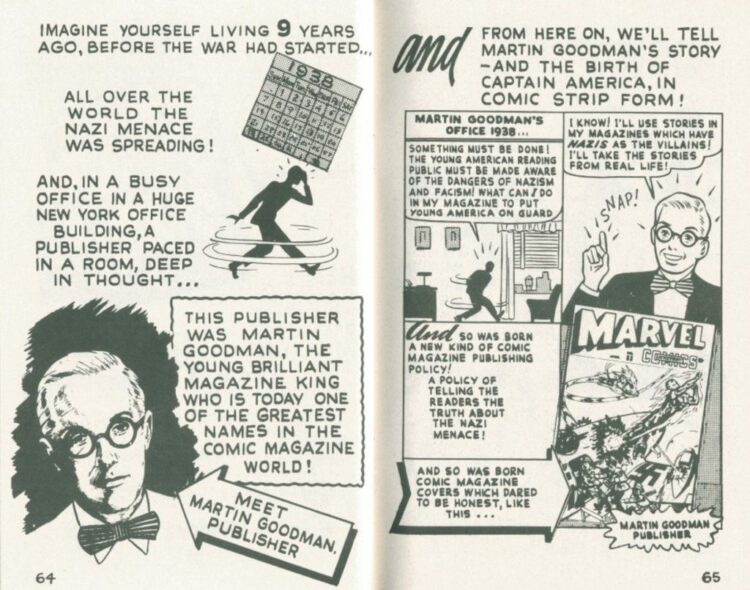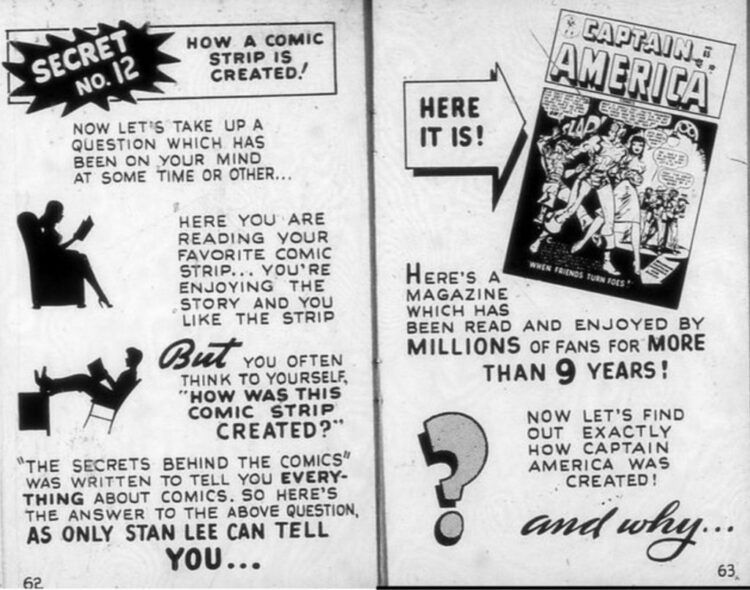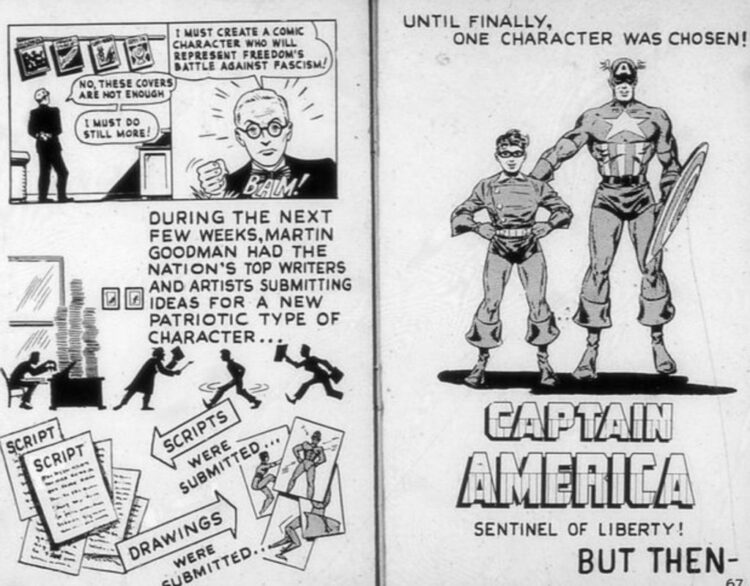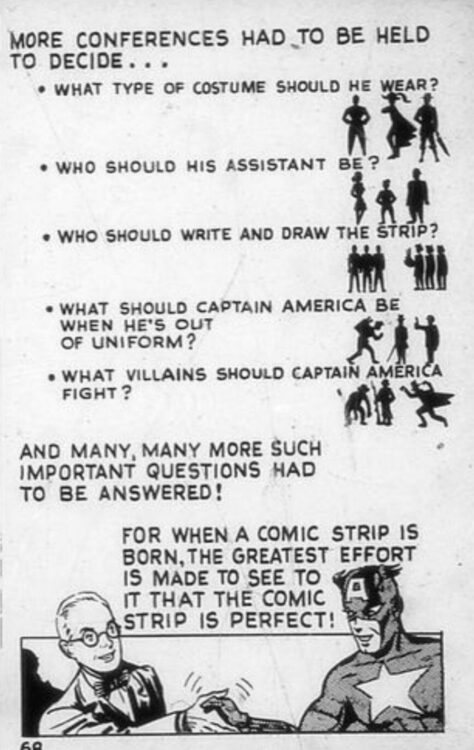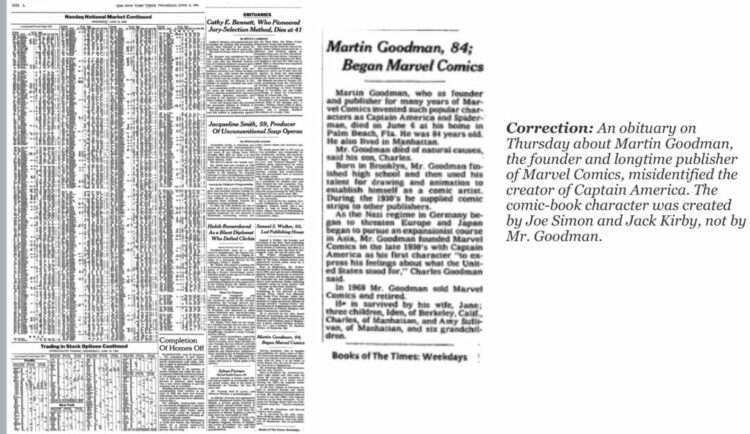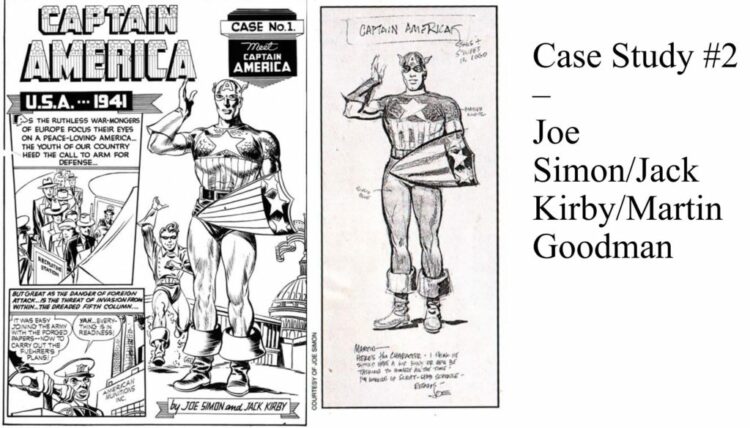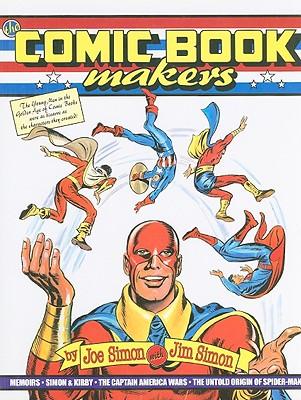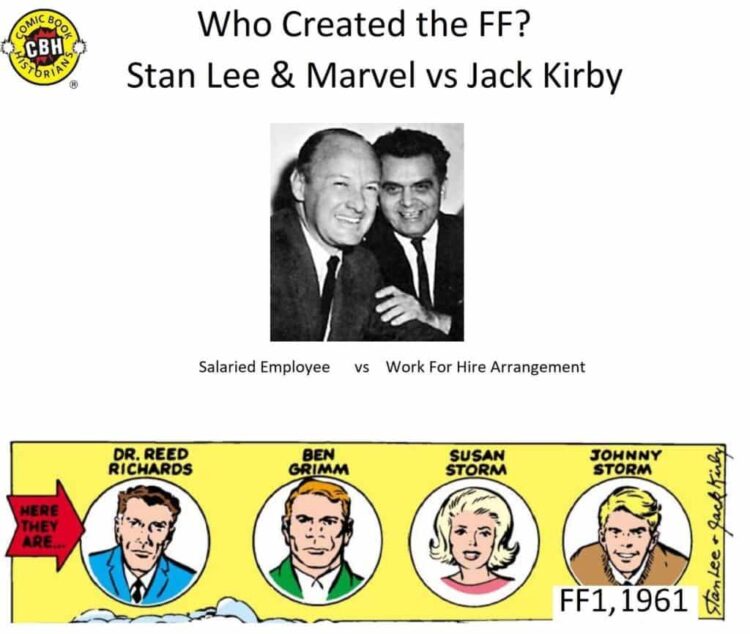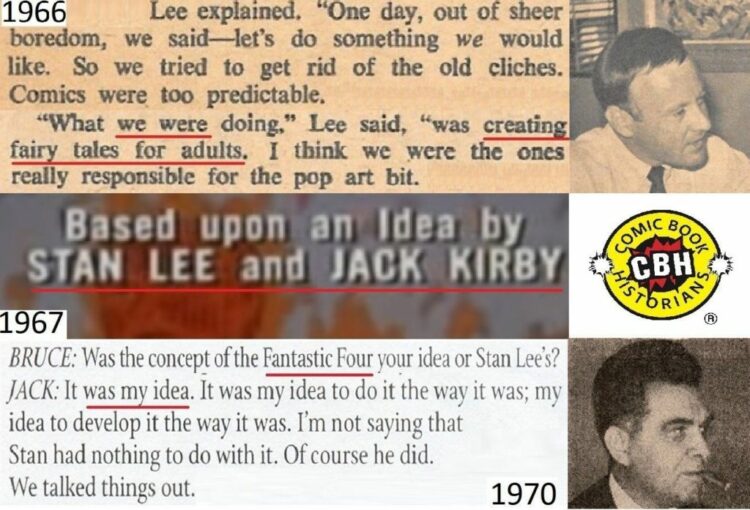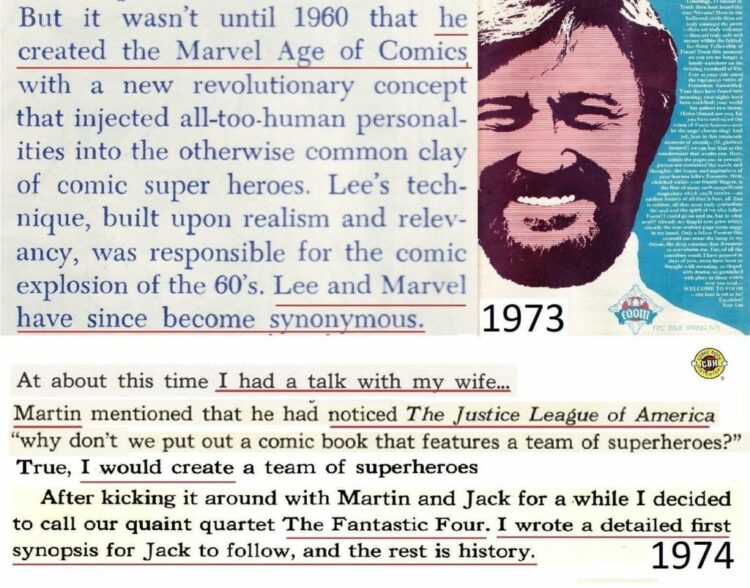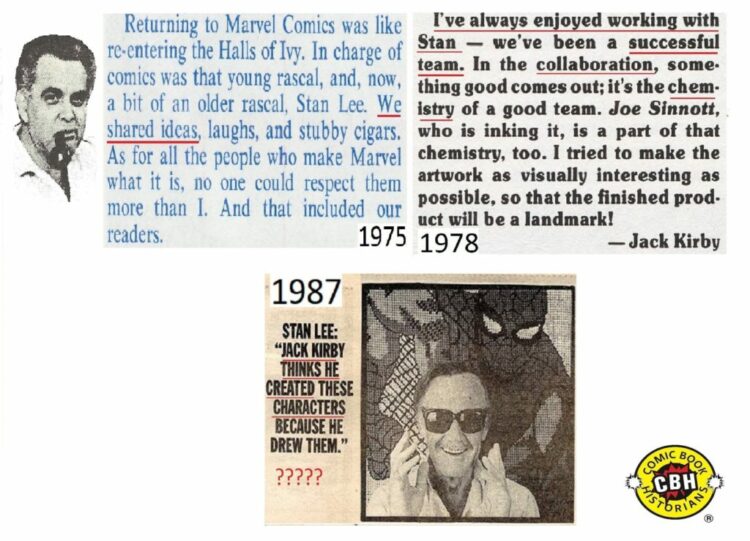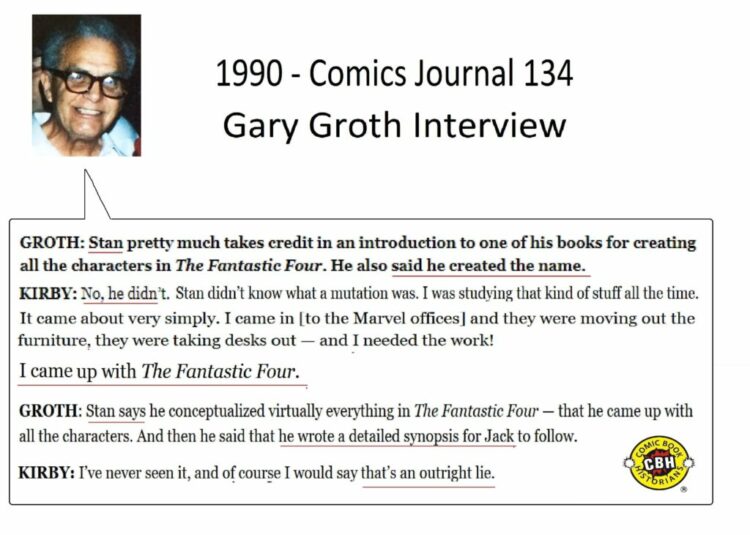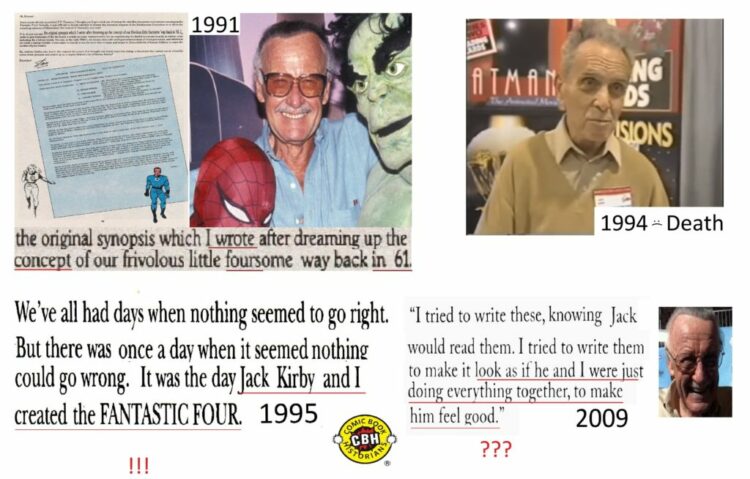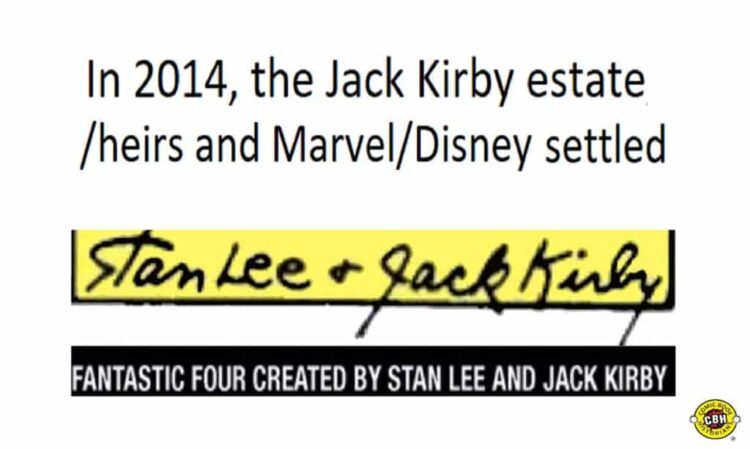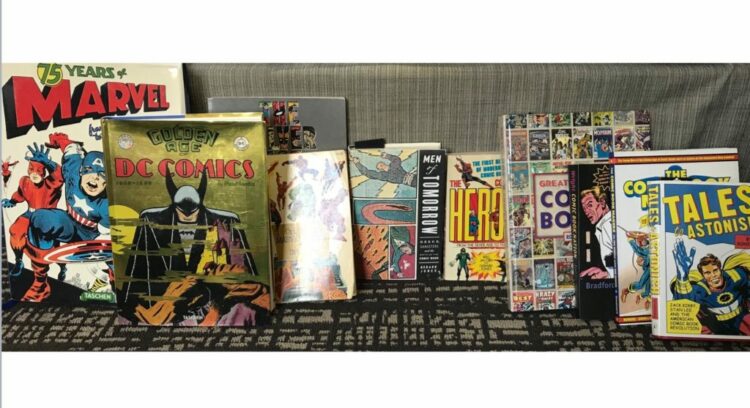SDCC2018 CAC Panel: Attorneys vs Historians: Who Authors The Authorship Narrative? with Alex Grand and Jim Thompson
CBH Presents The Comic Arts Conference Panel at San Diego Comic Con July 19, 2018 discussing how attorneys and historians have intersected in studying the creator credits of Batman, Captain America and the Fantastic Four.
Jim Thompson leads the panel and discusses Captain America’s ownership of Joe Simon vs Marvel Comics, Danny Barer discusses Batman and the Bill Finger vs Bob Kane creatorship debate, and Alex Grand discusses Jack Kirby vs Stan Lee & Marvel for ownership of the Fantastic Four. Marc Greenberg elaborates on his own personal experiences with Bob Kane and Jerry Robinson. Panel Originated by Jim Thompson, Audio recording and group panel photo by Jamie Coville, Video production by Alex Grand.
Jim Thompson: Hi. I’m Jim Thompson. I wanna introduce the panel, or I’m gonna have them introduce themselves, starting with Danny.
Danny Barer: I’m Danny Barer, known as Daniel Barer in the legal world. I’ve been a practicing attorney for close to 28 years, and I’ve been attending Comic-Con regularly since 1989 and a couple before that, and I’ve been collecting comics for about 40 years. So occasionally the legal and comic book worlds intertwine. In terms of practice, I mainly do appellate law, which means arguing on paper instead of arguing at trial, and it means I get to tell my stories in writing rather than telling them by putting together witnesses.
Alex Grand: I’m Alex Grand. I run a website called www.comicbookhistorians.com. Jim and I are admins on the Comic Book Historians Facebook group. Like Danny, I’ve been collecting comics most of my life, and comic history’s become a passion. I’ve gone to seven San Diego Comic-Cons.
Marc Greenberg: My name’s Marc Greenberg. I’m a Professor of Law at Golden Gate University in San Francisco. I’m the author of a book called Comic Art Creativity and the Law. I represent comic artists, comic writers. I’m a participant in the Comic Book Law School panel that runs all three days here at Comic-Con and I’m kind of an active participant in this comic universe representing clients, transactional matters, occasionally if it’s necessary in litigation.
Jim Thompson: And I taught for Duke University for 15 years in teaching genre as it applies to both film and comics. I am also a divorce attorney in Los Angeles. If anyone needs anything. Speaking of which, when I’m not teaching or buying comics or talking about comics, I do divorce people and it pays bills and it buys my comics, but divorces are often described as cases of he said, she said. Once he says and she says and the judge decides who said it correctly and who he’s going to believe, or she’s gonna believe. Comics history is often similar to this. More often it’s he said versus he said but nevertheless the historian ultimately decides which narrative to go with, just as the judge does. That’s not the only similarity and that’s what we’re gonna talk about today.
Jim Thompson: In a divorce, when it’s he said, she said, the lawyers help frame or refine those narratives from the sidelines, often whispering in the ears at the witness stand and also in preparation. Our point today is that there are often also lawyers on the sidelines in comics history, in their narratives as well, directing, refining what he said and what he said. However in court, the lawyers are in plain sight. In comics history, only The Shadow knows where the lawyers are lurking.
Jim Thompson: Hayden White in his influential Meta history: The Historical Imagination in Nineteenth-Century Europe 1973 and this is the academic side, not my lawyer side, observed that the history as a plenum of documents that attest to the occurrence of events can be put together in a number of different and equally plausible narrative accounts of what happened in the past. As Roland Barthes says, narrative is simply there like life itself, international, trans historical, transcultural. What this means is that there is a lot of different narratives and in doing a history of comics, there’s not one history, there are multiple histories in a post-modern sense.
Jim Thompson: Like estranged husbands and wives, co-creator, writers and artists have their own narratives. Lawyers sometimes refine those narratives or push favorable counter narratives as I said. Historians the people that are writing the history, create, and shape these narratives and to a narrative of history and then we create our own narratives as readers.
Jim Thompson: We’re gonna start by examining three examples of these comic narratives that become and turn into comic history, but, before I turn it over to Danny to talk about Bill Finger, and Bob Kane, and Batman, I wanted us to take a quick look at something as a bit of an exercise. This is from True Facts comic number five I believe, or Real Facts comic number five “The True Story of Batman and Robin” how a young Bob Kane is developing the notion of Batman in his mind from early on where he’s having a childhood friend dress up in a bat costume and he’s thinking about Batman even when he’s in school and, it goes through systematically every aspect of the Batman mythology and gives Bob Kane full credit for thinking of it, even to the points of Robin, even to the points of The Joker, all of the villains.
Jim Thompson: Everything comes purely from the mind of Bob Kane. And so that’s interesting because we all know it’s false, but it’s also interesting because you have to think about why? Why was this published? What was going on in everyone’s, in DC comics head that they did this? In each panel you can think somebody made the decision we should include a Joker panel, we should include a Batmobile panel, to give it ownership on the record in a sort of the way. With that said, I’m gonna turn it over to Danny to go to the next topic.
Danny Barer: Certainly, for decades the general line was that Bob Kane was as in that Real Fact story the sole creator of Batman and that was not an accident. Bob Kane had a contract with DC comics and national periodical publications it’s his previous name that was much better than that Siegel and Shuster had concerning Superman, the stories of how that had happened their conflicting and we’re not going to get into them but, the important thing was a writer named Bill Finger had a role in the creation of Batman that you’ll hear more about later but suffice it to say, without him, we would not have the Batman that we know and love today and certainly not the Batman that was in this show.
Danny Barer: Now, the show was being put together around 1965 around 1965 Bill Finger came to on of the very early Comic Cons, the Comic Cons we’re being held in New York. Afterwards, Jerry Bails, the father of comics fandom, Roy Thomas, and some other fans, big name fans went to Finger’s Greenwich village apartment and spoke with him and afterwards. Jerry Bails wrote an article for the Amateur Press Association Kappa Alpha that Bails published called, “A Finger in every Plot”, clever.
And then he talked about how Bill Finger was the unsung hero of Batman. Not only writing most of the early Batman stories along with other writers such as Gardener Fox, but also creating several key elements of the Batman legend.
Danny Barer: Around that time, Batmania which was a fanzine published by Biljo White, Tom Fagan was the assistant editor. This was the first fanzine I understand, devoted to a single comic book character and it was authorized by DC comics, they allowed it to be published. They started mentioning that a fellow named Bill Finger had been to the 1965 Comic Con and that he had talked about having a role in the creation, they talked about the Jerry Bails article and they said a little bit later they we’re going to have an open letter from Bob Kane. So a few of the editorials for Batmania said, “were gonna have this letter from Bob Kane coming.” then saying, “were gonna put off this letter from Bob Kane for a while.”
Danny Barer: According to Bill Schelly’s article about this letter from the 1998 alter ego issue of Volume two number three, there was an attempt between Bob Kane and Bill Finger, according to Finger, to try to work out informally, some of the points that were made in Jerry Bails article about Bill Finger creating key elements of the Batman legend, informally, I don’t know if lawyers were involved or not. They waited at Batmania to hear from Finger or Kane about whether this have been worked out, they didn’t hear anything so in the last issue of Batmania that Biljo White published which was number 17, they finally published the open letter from Bob Kane. And I’m just gonna read a few excerpts from it, it’s addressed to Biljo White the publisher.
Danny Barer: “Now, I’d like emphatically set the record straight once and for all about the many “myths” and “conjectures” that I read about myself and my creation Batman in your “fanzine” and other publications. I can only call all the stories I read about myself “conjectures” because most of them are written without my advice or consent and therefore, can not be entirely, the truth. For how can an article about me or the Batman be the true story when I am not consulted or interviewed? It only stands to reason then, that the writers what they think is the truth, by receiving their information from second and third parties in fragments until what I read is so distorted that I cannot believe that the person they are talking about is myself.” moving on a bit.
Danny Barer: “The myth, Bob Kane is not the sole creator of Batman, I’ve heard this a thousand times in my life time. That Batman was really created but Bill Finger, Jerry Robinson, Carmine Infantino, Jack Schiff, Julie Schwatrz, my publisher, etc., etc., and my housekeeper. The truth, all hogwash. I, Bob Kane am the sole creator of Batman, I created Batman in 1939, and, it appeared if memory serves me correctly, in Detective Comics as a six or eight page story, and I signed the first script, Robert Kane. I read your article that you sent to me if the truth be known “A Finger in every Plot”. “It wasn’t Biljo Whites article it was Jerry Bails article but oh, whatever.
Danny Barer: “And it seemed to me that Bill Finger has given out the impression that he and not myself created the Batman, as well as Robin, and all the other leading villains and characters. This statement is fraudulent, and entirely untrue, that is myth, and I quoted an except from the article written by Jerry G. Bails, “The Cowl and Cape”, the utility belt and gauntlets were all Bills contribution. Also further down article again I quote, “Bill also created Robin of course, but also Commissioner Gordon, who appeared in the first Batman story, Alfred, The Penguin, The Catwoman, etc, etc.
Danny Barer: The only proof I need to back my statement is that if Bill co-authored and conceived the idea, either with me or before me, then he would most certainly have a by-line on the strip along with me name, the same as Siegel and Shuster had as creators of Superman. However, it remains obvious that my name appear on the strip alone, proving that I created the idea first and the called Bill in later, after my publisher okayed the original creation.”
Danny Barer: Let me put this in context, Bob Kane was the one who decided that only his name would go on the strip, that was in his contract, he is now citing that as proof that Bill Finger had no involvement. We have a fancy legal phrase for this kind of argument, it’s called, “ipse dixit” which literally means, “he himself said it”. And figuratively means, “IM citing myself”. Mr. Kane goes on.
Danny Barer: “Attention Jerry G. Bails, the self appointed authority on Batman. If Bill Finger created Batman, as you wrote, where is Bill Finger’s byline on my strip? It is conspicuous but its absence. So?” going down a little bit more.
Danny Barer: “Aside to Jerry G. Bails, I ought to sue you for misrepresentation and distortion of the truth about your Finger Article, that blatantly intimates that Bill Finger was the true creator behind Batman, and not Bob Kane. Your article is completely misleading, loaded with untruths fed to you by Finger’s hallucinations of grandeur. May I say to you, Mr. Bails, that before you wrote so smugly ans assuredly about Bill Finger being the real creator and tour de force behind the Batman for publication, don’t you think that you should have double checked your information back to me, so that I could verify and clarify Bill Fingers comments?”
Danny Barer: We have, a legal phrase for this sort of argument where you say something blatantly false and then challenge the person who’s countered you by saying “ill sue you.” it’s called, “chutzpah”
Audience Member: It’s called what?
Danny Barer: Chutzpah, if you want the definition of that look at Leo Rosten “The Joys of Yiddish”, it’s a legal definition. So we don’t know whether there was a lawyer involved in writing this article, or writing this open letter along with Bob Kane or not but a clue to why it came out besides Mr. Kanes ego, is later in the article or the letter where he talks about this new exciting show, that’s coming out in the winter of 1966 Batman. Now, there’s potentially fame and fortune from Batman, and there’s also an incentive for Mr. Kane to maintain that he is the sole creator and that is so that he gets a card at the end of the credits that says, “based upon the characters created by Bob Kane.” and all the fame, fortune, merchandising etc., that conveys, incidentally, he wrote into Mr. Doziers saying, the producers, saying, “I really like that card, can you make it stay on the screen longer?”
Danny Barer: So, the ultimate result is this really didn’t go much farther in 1965, in 1973 Bill Finger passed away. Before he passed away however, he did have his one public credit associated with Batman and that was that he co wrote a two parter for the Batman TV series starring The Clock King, which had all these Bill Finger trademarks like, giant props and giant clocks come to life. He got pictures on screen the credit that perhaps Bob Kane feared most, but perhaps one he feared even more was a few years ago, Bill Fingers family and DC did come to an arrangement where Bill Finger got some credit and so we go the credit that we see from the 2016 movie Batman VS Superman: Dawn of Justice. Jim.
Jim Thompson: Thanks, so as I get with detective, with Batman comics I’m going to do here and shoe another one, this is a story of the origin of Captain America and who created it and as we go through that we snap and we know that it’s actually Martin Goodman who created Captain America. This is Stan Lee telling all about his relative created Captain America, and that he assembled, called in a bunch of writers and asked them to come up with a story and the nations top writers and artists and finally one character was chosen, Captain America’s Sentinel of Liberty. Then there had to be more conferences, and all of that, leaving out the names, Kirby, and Simon, all together.
Jim Thompson: It’s basically Captain America shaking hands with Martin Goodman, and when Martin Goodman died, the New York Times had his obituary that actually said that he invented characters like, Captain America, and Spiderman. It then, a couple days later it showed a correction saying that they we’re wrong, apparently Goodman only invented Spider man, and not Captain America. So, that’s a narrative, and that’s what we’re talking about, it’s not gonna be the narrative that history finds, publishes most of the time. That goes between Joe Simon and Jack Kirby and this would be the first picture that goes Simon says that he sketched and gave for his pitch for Captain America, which was used in the first story in 1941.
Jim Thompson: Simon and Kirby only produced ten issues of Captain America for Timely Comics before they were actually let go from the publisher for what they thought were contract, well they didn’t have contracts, so you can’t say a contract breach, but for working for someone else. Simon had said subsequently in a lawsuit, I’m not sure if it’s a deposition, or he court papers but, he said that, he had sold the Captain America story to Timely for a fixed pay trade plus a 25 percent share of the profits of the comic books. There was no written contract Simon acknowledged that he, well what he did was in 1967 he filed a lawsuit. In the south district of New York he saw that he had filed another one in 66, he sought the court to declare that of the soul right to copyright renewal under the Copyright act of 1909, like I said he had previously filed a New York state court under unfair competition and misappropriation of his state law property.
Jim Thompson: Though in the 67 case the party settled as part of the settlement, Simon acknowledges contributions were worked for a higher and he signed any and all rights tied to an interest that he made of had to Timely. What’s interesting about that is the back and forth between Kirby and him and why that took place. So in the autobiography comic book makers chose Simon for recounts his creation of Captain America, and he says, “it was a time of intense patriotism [inaudible 00:19:52] soldiers, shooting war toys at imaginary soldiers. Wouldn’t they love to see him lambasted in a comic book? By a soldier? A meek humble private with muscles of steel and a color full of star bangeled costume under his khaki army uniform. Wouldn’t we all? He describes very similar to Jerry Siegel talking about the night that he spent and emerged from his house, or from his bedroom with the notion of Superman.
Jim Thompson: He says, “I stayed up all night” Simon says, “I stayed up all night sketching the usual athletic figure, mailed armatures, bulging arm and chest muscles, skin hugging tights, gloves, boots, flapping and folded beneath the knee, I drew a star on his chest striped from the belt to align below the star, and color the costume red, white, and blue. I added a shield, as a child I have bee and hung up on shields, the designs seemed to work, the muscles of the torso rippled gallantly” he talks a lot like that “under the red and white stripes there was one thing bother me that we had to have a companion” and he goes on and he explains how he came up with Bucky.
Jim Thompson: “I wrote the name Super American at the bottom of the page, no it didn’t work, there were too many supers around. Captain America had a good sound to it, there weren’t a lot of Captains in comics it was as easy as that. The boring companion was named Bucky after my friend Bucky Pearson, a star on their high school basketball team. Like the Batman cartoon I showed at the very beginning, it seems like he’s covering each and every aspect of the Captain America legend. And making sure that it’s all coming from his head and nothing to do with his partner Jack Kirby.
Jim Thompson: Jack Kirby, in an affidavit at the time in 1966 or 67 during the lawsuit, Marvel had him address this. Most likely by saying, “hey, Joe Simon is taking all the credit for this and we need an affidavit from you.” so Jack Kirby said, “I believe Joe was an editor at the time in charge of production of the comics magazine, I was hired as an artist to work full time on a regular salary, to help create comic magazines and characters. The offices at that time were in the McGrall Hill building, they were no set comic characters that’s at such at Timely at the time I was hired. They were created by us to produce a comic magazines. Many of the characters were not in existence at the time and had to be produced from the top of our heads. The characters that were becoming the strongest were the Superman type characters.
Jim Thompson: These we’re the strongest selling types as the country was beginning to be in a patriotic stir. They were saleable, discussions took place practically everyday on the bases creation of characters and the frame work in which to present them. More types of villains, what they need to face personalities involved and the type of gadget to be used. Characters began to evolve from those discussions, there were sketches made of the characters and their costumes and these were changed and modified until they assumed what we considered the correct appearance of the product we saw. We used Hitler and the Nazis as perfect villains, there was also a matter of remolding a characters and then the change in Captain Americas shield. From that shield to the circular one.
Jim Thompson: In the course of the discussion we first evolve a main character then begin to build around him, I suggested the use of a sidekick who we named, Bucky. Joe decided the type of lettering to be used on the Captain America cover, it was the only thing I couldn’t do, all my work for Timely was basically superhero oriented. There were general outlines for Captain America we worked out together, there were times when I would wake up with a theme that we both thought would make a good story and I worked it out in its entirety. Joe was more preoccupied with other things as production editor, but sometimes he would suggest a story which I would work out. Joe was very busy and didn’t have time to do any himself.
Jim Thompson: Sounds very much like the Stan Lee, Jack Kirby narrative that we’re gonna hear about from Alex, what I think is really interesting about is when you get into the why’s on this, because Marvel had a strategy at the time when Joe Simon is suing, where because he’s saying that he was the creator and it was not a work for hire. What happens is, even if the say that’s true, Jack Kirby was the co creator so Marvel unlike any other time that they’ll do it, they’re actually pushing Jack Kirby as the co creator as something, rather than saying he was just the artist. So they have him do this affidavit, taking co credit for it because it directly impacts the pending lawsuit.
Jim Thompson: So this is again where it doesn’t come in to traditional histories as we’ll get to when we get to the next section. But it’s clear that it actually is all about legal maneuvering on both sides basically. And now to skip in time a little bit and to continue with Marvel.
Alex Grand: Who created the Fantastic Four, Stan Lee vs Jack Kirby? and how does that factors into Marvels ownership of the characters? This is a picture of Stan and Jack in the 1960s and although they appear to be chummy they have different working arrangements with Marvel Comics at the time. Stan Lee was a fully employed editor and chief on salary and Jack Kirby had a work for hire arrangement so they had very different legal situations but they were working for Marvel at the time. We see the very first issue of the Fantastic Four and there’s a byline right when you see the four characters and it says, “Stan lee + Jack Kirby”, so there is a co-authorship from those men listed on that first issue. Although they are listed side by side, it doesn’t say who wrote it, who drew it, although we know some of those things now but it doesn’t really exhibit how different their legal situations were working for Marvel at the time, but side by side, there’s a co creator ship implied there.
Alex Grand: Then fast forward to 1966 and Stan Lee was interviewed at the Chicago Sentinel Times and he was speaking a bit more collaboratively he was saying, “we’re creating fairy tales for adults,” and when we look at the credit on the Hannah Barbara Fantastic Four cartoon in 1967, it says at the very end based upon an idea by Stan Lee and Jack Kirby. So this is again, a couple of very collaborative statements. Later in 1970, two years into Perfect Film and Chemical buying Marvel Comics from Martin Goodman, Jack Kirby leaves Marvel and we see that in the Blast comic collector 81 he says that the Fantastic Four was his idea, and that it wasn’t a co creator ship as he goes over to DC comics.
Alex Grand: So then we fast forward a little bit more and Martin Goodman left his publisher seat in 1972 and Perfect Film & Chemical chooses Stan Lee to be the succeeding publisher instead of Martin Goodman’s son, Chip. In 1973 a year later, Jim Steranko makes FOOM 1, the new official Marvel Fanzine made which documents that Stan created the Marvel age of comics with no mention of Kirby and that Stan and Marvel have become synonymous. A year later Stan Lee releases Origin in 1974 and he writes that, “I had a talk with my wife, I had a mid life crisis, Martin Goodman mentioned the Justice League of America why don’t you create a team of superheros.” Stan then creates the narrative that he wrote a detailed first synopsis for Jack to follow and visualize and “the rest is history” so there’s this interesting effect here in which Stan helped solidify Perfect Film and Chemicals ownership over the characters by making these statements. Essentially it works if Perfect Film can keep Stan Lee happy, who was an employee with salary relations with Marvel during the 1960s creation of the characters, with a permanent job, a nice position and good pay then he will continue to keep Perfect Film happy by saying he was the creator and that helps tighten their hold on the characters of Fantastic Four and other characters that follow. That essentially cuts Jack Kirby out the action despite his getting creator credit earlier in the 1960s, but was achievable with Jack Kirby not being at Marvel at the time.
Alex Grand: And now in 1975 Jack Kirby returns to Marvel, and he says, once working at Marvel that Stan Lee and he “shared ideas” and “laughs” and there is more of a collaborative statement again. For Jack it seems like when he worked for Marvel he’d speak of them more collaboratively but then when he leaves Marvel it’s more like, the Fantastic Four was his and that’s all there is to it. In 1978, Stan Lee and Jack Kirby made his Silver Surfer graphic novel together, so they worked together again and Jack said that he always enjoyed working with Stan and that it’s a successful team and collaboration. So again, it’s more of a co creator type of discussion. Later on that year, Jack Kirby leaves Marvel for animation and in the 1980s a lot of the comics say Stan Lee Presents. In 1986, New World Cinema buys Marvel comics and what’s interesting a year later Stan Lee says “Jack Kirby thinks he created these characters because he drew them.” In the face of new corporate ownership from New World Cinema, that helps again solidify the new corporate leadership’s hold on the characters in much the same way that it did soon after Perfect Filming and Chemical had just bought it.
Alex Grand: It appears to be legally consistent to say that in regards to the relationship between Stan Lee and Marvel, if they can keep each other happy then the money keeps coming in. In 1990 there’s Comics Journal 134, the Gary Groth interview and Gary Groth discusses 1974 Origins with Jack, “Stan pretty much takes credit in an introduction to one of his books for creating the … Fantastic Four… created the name.” Jack Kirby says no he didn’t, “I came up with the Fantastic Four” and Groth asked “Stan says” he wrote a detailed synopsis for you to follow and Kirby says, “I’ve never seen” that synopsis, “that’s an outright lie.” So in 1989 Revlon buys Marvel from New World Cinema and then a couple years later, their Chief Executive Ronald Perelman takes Marvel public. So in 1991, there’s a lot of money coming in and Fantastic Four 358, 1991 Stan Lee writes, “here is a copy of the original synopsis” he printed out in the issue and above it he writes, “here’s a synopsis that I’ve bee talking about since 1974 and this is the one I wrote when I dreamed up the Fantastic Four back in 1961.”
Alex Grand: This statement in FF358 function again to legally solidify the new corporation’s hold on the characters, which is helpful since money’s coming in from going public and Stan Lees happy and Marvels happy. It also acts as a legal document and rebuttal to Jack Kirby’s narrative that he never saw any sort of synopsis. So then in 1994 Jack Kirby dies, and then in Fantastic Four 400, in 1995 Stan Lee writes that he remembers the day that both Jack Kirby and him both created the Fantastic Four. So it’s a big inconsistency and likely a guilt reaction of some kind, but potentially more true than what he stated for 20 years before. So, fast forward about 14 years, in August 31st, 2009, Disney buys Marvel and the Jack Kirby estate two weeks later filed suit to go after ownership of the Marvel characters and Marc Toberoff, the lead attorney for the case represented Jack Kirby estate subpoenas Stan Lee and says how do you reconcile the fact that at one time you said you created it yourself, and then at other times you co created it and Stan Lee says, “I tried to write these knowing Jack would read them I tried to write them to make it look as if he and I were just doing everything together to make him feel good.” This quote from Mark Evanier’s Kirby King of Comics book. All the attorneys are present, and the marvel money on the line so Stan Lee keeps true to form like he did back in 1974 that if he denies any sort of creator authorship from Jack Kirby then he helps tighten Marvels hold on the characters. This is basically the role he’s been playing as well as promoting the Marvel brand which everyone has fallen in love with. So that case did not make it and the Kirby estate did not win ownership, it got appealed a couple times and they kept losing. The main reason was due to Jack Kirby’s work for hire relationship. In 2014 the Kirby estate tried to take it to the Supreme Court and Disney essentially settles out of court because they don’t want to deal with the supreme court fallout. Finally Kirby gets credit, there’s a settlement to the Kirby family and essentially now the byline in all the Fantastic Four magazines finally say Fantastic Four created by Stan Lee and Jack Kirby, just like that original byline said in the very first issue that came out over 50 years ago.
Alex Grand: That how that resolved.
Danny Barer: Alex, one curious thing to me, as a lawyer is that in the Origins book when Perfect Filming and Chemicals trying to nail down that they own these characters that part of that official narrative is that Martin Goodman ripped off National Periodical Publications Justice League. It’s curious that you say you’re ripping off another cop to ripping off another publishers’ concept in solidifying your own. I can only say either that, it felt there was more authenticity in putting in that element of taking the idea from somebody else. Or maybe its just true.
Alex Grand: Yes and there’s this also this interesting directive that Martin Goodman said create this so then it becomes his creation and it’s a funny pattern of, well if you tell someone to build it and they build it, who created it? It’s a weird concept.
Jim Thompson: What I wanted to do now, very briefly is what we’ve heard is voices telling their stories and their narratives but now we want to look at how history books take those voices and narratives and chooses which ones to go with. And these will be very brief and then we’re gonna open it up to talk about the legal aspects, the silent, the quiet voices in the background. From Captain American, and this is from Tales to Astonish he basically, the author basically repeats what Simon is saying “one night Simon settled a sketch board to design the star spangled hero who’s alter ego was a timid army private in Khaki uniform”, he wrote the name Super American on the bottom of the first sketch but immediately changed his mind to Captain America he wrote over it.
Jim Thompson: Simon submitted the character to design to Goodman with a short note at the bottom, Goodman told Simon, let’s do it we’ll give Captain America his own book. Simon mentioned he’d like a piece of the action. Simon had to put a rush on putting it together, when Jack heard Simon had asked artist Al Avinson and Al Gariel, who’s work resembled Jacks work on the first issue, he asked, “why? You’re still number one Jack it’s just a matter of a quick deadline for the first issue.” Jack said that he’d make that deadline.
Jim Thompson: So in this book it’s totally taking Kirby out of the initial construction of Captain America along the lines that Joe Simon did in his biographies and which he was doing as part because of his desire to terminate the copyright.
Danny Barer: And in 2004 Men of Tomorrow by Gerard Jones talked about the Kane and Finger situation such as this way. Kane and Finger told different versions of what happened next. Kane in fact told several versions himself, the earlier ones excluding Bill Finger entirely, the later ones, under pressure from fans who kept finding more evidence of Fingers involvement acknowledging a small contribution from a friend. Kane would even go so far as to forge sketches that he supposedly drew in January of 1934, “the age of 13” showing a Batman, a Hawkman, and an Eagleman, inspired by Leonardo Di Vinci’s sketches of a wing like flying machine.
Danny Barer: so he tried to prove not only that Finger hadn’t helped him, but that he couldn’t even have been inspired by the Birdman and Flash Gordon. Which he’d already cited his influence in interviews, in one document Kane lied about his age, stole Fingers credit, placed himself in the Renaissance tradition and nicked a bit of glamour from the man who created Hawkman. Even for Bob this was a master stroke of braiseness.
Alex Grand: So then in The Heroes by Will Jacobs and Gerard Jones 1985 this is after, well after origins but before Jack and Kirbys in 1990 interview it says, “as history, Jones wanted me to narrow down and make something of myself” Stan Lee says. And her timing couldn’t have been better, Kirby had just recently joined the staff and Goodman asked Lee for the costume hero team that was similar conception to the Justice League. And so what’s interesting about that is that if again, furthers that Stan Lee narrative that he discussed about in Origins.
Jim Thompson: So Marc you’ve been listening, have you heard the fingerprints of any lawyers in any of this?
Marc Greenberg: Well I have a couple of quick anecdotes I can add to the dialog.
Jim Thompson: Okay.
Marc Greenberg: In the 1980s, Bob Kane wrote his own biography, and it was a terrible, misogynistic, 900 page mess. Which he tried to sell and got absolutely not traction, he was approached by a fellow named, Thomas Andre. Now Andre who was well known comic historian living in Berkeley. Tom completely reformulated this at Bobs request, he managed to get DC to not only work with Bob on this but manage to get DC to give him lots of illustrations, and with him a book came out it was called, “Batman and Me”, and it was Bob Kane with Tom Andre. Later Bob refuse to pay Tom, and took the vision that Tom was just an editor. And he sued Tom, to get the declaration that Tom wasn’t paid a writer of work and I represented Tom, first thing, they sued Tom in Los Angeles figuring that Tom would roll over pretty easily because he’s up in the Bay area. So we filed motion to change venue, and move the case up to the Bay area and the motions granted by the court in L.A.
Marc Greenberg: At which point I started getting calls from Bob’s very concerned lawyer that maybe they were actually going to have to defend themselves. And they settled the case and paid, and had to start paying Tom, one of the important things though that Tom had done in his dialog with Bob that in the course of doing Batman and Me is he talked with Bob about the Bill Finger matter. Now this was in the eighties, and Bob said, “oh you know, I wish I could of done this differently, I would of given credit to Bill.” subsequently when Finger family brought their claims with DC the first thing DC said was contractually, we have to give only Bob the credit because his name is on the contract and we couldn’t do it any other way, he never said, that he acknowledged Bill’s contribution.
Marc Greenberg: The Finger family was able to appoint to Tom’s interview where Bob had said, “actually, I would given him the credit.” and that was a key factor in the subsequent ed decision to give that credit to Bill Finger, it came out about a year or so ago. So that’s one short thing, another quick thing I would add is I had the chance to talk to Jerry Robinson, who is largely credited with creating Robin, and I asked him about Fredrick working with him in the 1954 book Seduction of the Innocent says that Batman and Robin is a homoerotic relationship, all these pictures of Robin sitting at Batman’s, Bruce Wayne’s knee, all this sort of thing. And they ask him, I asked Jerry, “Jerry, were you creating homoerotic relationships?” and he’s says, “hell no, I based Robin on Prince Valiant movies at the time.” and that’s why the outfit has the particular look, that outfit is based on the Prince Valiant material.
Marc Greenberg: So I guess what I would comment on simply that the letters of history in comics in particular have often been influenced by the role of lawyers in these lawsuits. And that would be my comment.
Jim Thompson: That’s great, thanks.
Jim Thompson: So to sum up in just a couple of things going back to that very initial Batman comic where I asked you to think about what the motivations are and why? When we’re dealing with history books about comics, a few questions, does a historian, is he obligated to tell both sides or at least to say that there are two sides? This is what Jack Kirby says but Joe Simon says something different. When it’s done the way it is in the example I read a few minutes ago, where it’s simply Joe Simon’s version, you’re not aware of the other aspect. When a historian tells a recanted or revised version such as, how somebody, Jack Kirby changes his version from what he had said in that affidavit to something quite different later in the Comics Journal interview.
Jim Thompson: Does the historian, should the historian do both the recanted or the revised version so that the reader understands that it’s fluid and not one story? Does the historian and going to just to this panel, does the historian owe it to the readers to explore the legal manipulations or the legal background of these statements such that when you’re reading it you realize that it’s not necessarily just ego, Stan Lee may have a tremendous ego but when he wrote this he was doing it under specific encouragement and requirements by the company to establish that he was the sole creator in order to prevent future lawsuits and creator demands. Those would be the questions I think that one asked when you’re looking at a more post modern notion of multiple narratives in a history book. I want to thank everybody for coming and the panels all for participating.
Join us for more discussion at our Facebook group
check out our CBH documentary videos on our CBH Youtube Channel
get some historic comic book shirts, pillows, etc at CBH Merchandise
check out our CBH Podcast available on Apple Podcasts, Google PlayerFM and Stitcher.
Batman ©DC Comics, Captain America ©Marvel Comics, Fantastic Four ©Marvel Comics, Images © Their Respective Copyright Holders
Use of images are not intended to infringe on copyright, but merely used for academic purpose.








